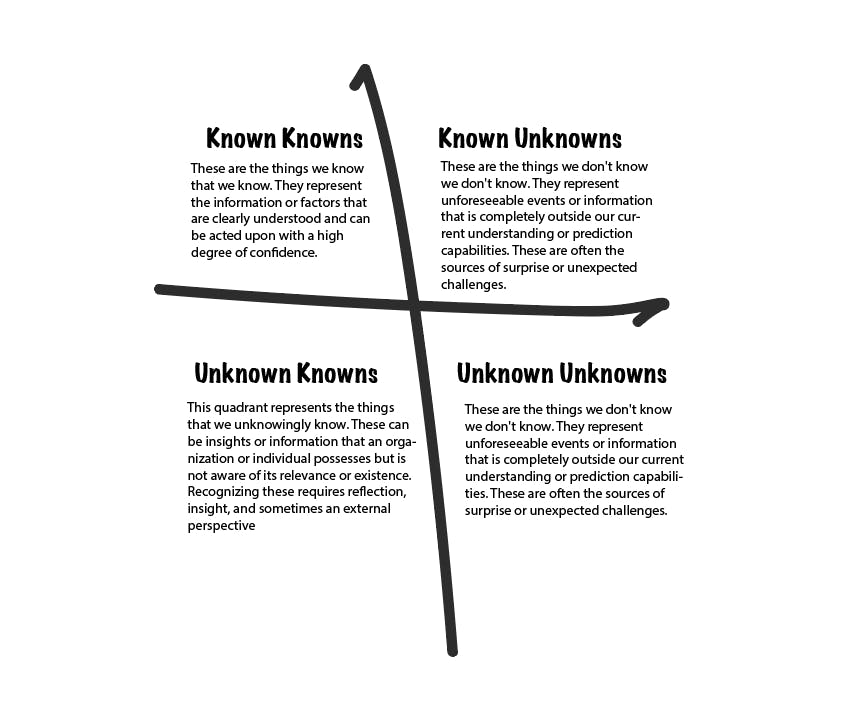The Rumsfeld Matrix in Software Development
How to Predict the Unpredictable in Software Development: Applying the Rumsfeld Matrix in Software Development
Table of contents
- Understanding the Rumsfeld Matrix
- Applications of the Rumsfeld Matrix
- Applying the Rumsfeld Matrix in Software Development
- Identifying Risks and Uncertainties
- Planning and Resource Allocation
- Enhancing Communication and Knowledge Sharing
- Continuous Learning and Adaptation
- Retrospectives and Improvement
- Conclusion
The Rumsfeld Matrix, named after former U.S. Secretary of Defense Donald Rumsfeld, is a framework initially used in the context of national security and defense to categorize the knowns and unknowns in decision-making processes. Rumsfeld famously explained the concept during a news briefing in 2002, introducing the terms “known knowns,” “known unknowns,” and “unknown unknowns.” This framework has since been applied in various fields, including software development, where it can be used to manage risks, make informed decisions, and navigate the complexities of projects. In this article, we explore how the Rumsfeld Matrix can be effectively utilized when developing software.
Understanding the Rumsfeld Matrix
The Rumsfeld Matrix is divided into four quadrants:

Known Knowns: These are the things we know that we know. They represent the most secure type of information, forming the basis of most direct decision-making processes. In a business context, this might include current cash flow, existing customers, and known competitors.
Known Unknowns: These represent the things we know we don’t know. They are uncertainties or gaps in our knowledge that are recognized and can often be addressed through research or data gathering. For example, a company may be aware that it doesn’t fully understand a new market it is considering entering.
Unknown Knowns: This quadrant consists of things we unknowingly know or the knowledge we possess but are not aware of. This can include ingrained skills or implicit knowledge that can be tapped into or revealed through processes like brainstorming or deep reflection.
Unknown Unknowns: These are the things we don’t know we don’t know. They represent unforeseeable events or information, often referred to as “black swan” events. Managing these unknowns is challenging and typically involves building robustness and resilience into systems to mitigate the impacts of unforeseen shocks.
Applications of the Rumsfeld Matrix
The Rumsfeld Matrix has been applied across various fields, from military strategy to business planning and risk management. It offers a structured way to think about uncertainty and the limits of knowledge, encouraging decision-makers to consider a broad spectrum of possibilities and to prepare for the unexpected.
In business, the matrix can help identify gaps in market understanding, potential risks in a project, or areas for innovation. In the context of risk management, it serves as a tool for identifying and categorizing risks to better prepare for and mitigate them.
Applying the Rumsfeld Matrix in Software Development
Identifying Risks and Uncertainties
The first step in applying the Rumsfeld Matrix to software development is to categorize the aspects of your project into the four quadrants. This exercise helps in identifying risks (known unknowns and unknown unknowns) and clarifying what is well-understood (known knowns) about the project. By doing this, teams can prioritize areas that need research, additional resources, or contingency planning.
Planning and Resource Allocation
For known knowns, teams can proceed with confidence, allocating resources and planning timelines based on established knowledge. For known unknowns, allocate time for research and exploration to convert these into known knowns, or at least plan mitigation strategies for dealing with them. Unknown unknowns are harder to plan for directly but setting aside a buffer in the project timeline and budget can help manage these unforeseen challenges.
Enhancing Communication and Knowledge Sharing
Addressing unknown knowns involves improving communication and knowledge sharing within the team and organization. Encouraging a culture where team members share insights and knowledge can turn unknown knowns into known knowns, benefiting the project and reducing unnecessary uncertainties.
Continuous Learning and Adaptation
The software development process should be flexible to accommodate new information as unknown unknowns become known unknowns or known knowns. Adopting agile methodologies can help teams adapt to changes and incorporate new learnings into the project efficiently.
Retrospectives and Improvement
After a project’s completion, conducting retrospectives can help identify what was learned, what challenges were encountered (and how they were overcome), and how the process can be improved for future projects. This reflection can transform unknown unknowns into known knowns for future projects, enhancing the organization’s knowledge base.
Conclusion
The Rumsfeld Matrix provides a useful framework for navigating the uncertainties and complexities inherent in software development. By categorizing the elements of a project into known knowns, known unknowns, unknown unknowns, and unknown knowns, teams can better manage risks, allocate resources effectively, and adapt to new information. This strategic approach not only aids in the successful completion of projects but also contributes to the continuous improvement and learning within the organization.
